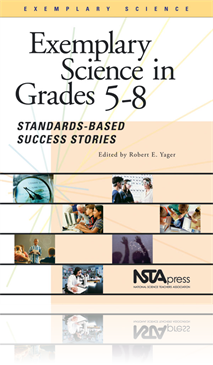All Resources
Book Chapter
Teaching Science With Student Thinking in Mind
This chapter describes the Discover Lab Concept (DLC), a project that began in a teaching/learning laboratory at Stony Brook University, and today is a foundation of science instruction in classrooms on Long Island and regions beyond. The chapter des...
Book Chapter
Unlocking the National Science Education Standards With IMaST
The National Science Foundation funded the IMaST project for three consecutive developmental cycles to design an integrated middle school curriculum. As a developmental research project, the IMaST developed 16 standards-based curriculum modules that ...
Book Chapter
Achieving a Vision of Inquiry: Rigorous, Engaging Curriculum and Instruction
The changing emphases of the National Science Education Standards (NSES) have spurred many school districts to reinvent their science programs. New curricula development by National Science Foundation-funded programs have been at the core of some dis...
Book Chapter
Adapting the JASON Project: Real Science, Real Time, Real Learning
The JASON Project is a multidisciplinary curriculum involving real science studies and comparing them to local studies performed by students. The Plymouth Public School System, located on the south shore of Massachusetts, adopted the JASON Project as...
Book Chapter
"Re-Inventing" Science Instruction: Inquiry-Based Instruction in a Fifth/Sixth-Grade Classroom
The author's purpose in sharing her experiences in this monograph is to help other teachers who may be less confident in teaching science than they are teaching other subjects, to help them see the value in what the Standards envision for students, a...
Book Chapter
What Do We Get to Do Today? The Middle School Full Option Science System Program
This chapter presents the Full Option Science System (FOSS) and the features that address the four National Science Education Standards (NSES). With FOSS curriculum students are introduced to content through exploration of and asking questions about ...
Book Chapter
ARIES: Science as Discovery . . . and Discovery as Science!
This chapter presents Project ARIES, developed at the Harvard-Smithsonian Center for Astrophysics and funded by the National Science Foundation, with additional support from Harvard University and the Smithsonian Institution. ARIES is a modular, astr...
Book Chapter
The 15 previous stories give evidence of the Standards' impact, along with important examples for others for improvements they might consider if they want to move in directions like those advanced by the persons involved in preparing the Standards. A...
Book Chapter
In light of the increasing emphasis placed on the importance of teachers and their actions and the reality that we have an inadequate pool of qualified science and mathematics teachers to meet our needs, many reform efforts and funding initiatives fo...
Book Chapter
Teaching Science With Pictures
The state of Texas is divided into 20 Regional Education Service Centers (ESC). Schools located in three of the independent school districts of the largest region—Region IV ESC—were selected as pilot sites for a program designed to increase stude...
Book Chapter
Finding Out What...and How They Know
The setting for this chapter is Hawkins Middle School located in a small rural city, the county seat of one of the poorest counties in Wisconsin. In this project students engaged in a learning experience that was integrated across subject areas and f...
Book Chapter
The reader may question how the "Teach them to fish" proverb relates to science education. Yet, a shift in emphasis from presenting knowledge through lecture and demonstration to encouraging active learning, in which students learn with understanding...
Book Chapter
Creating a Classroom Culture of Scientific Practices
Scientific practices are the activities that scientists engage in as they investigate the natural world. These daily practices include asking questions, designing investigations, finding, incorporating, and using information, collecting and organizin...
Book Chapter
More Emphasis on Scientific Explanation: Developing Conceptual Understanding and Science Literacy
This chapter describes a process for engaging middle school students in writing scientific explanations in the context of project-based science. In four Detroit classrooms, teachers enacted strategies for explanation writing that aimed to help studen...
Book Chapter
Traveling the Inquiry Continuum: Learning Through Teacher Action Research
This chapter addresses the More Emphasis on Teaching and the Content and Inquiry Standards from the National Science Education Standards (NSES). Using the knowledge gained through the Community of Excellence in Mathematics and Science (CEMS) program,...



